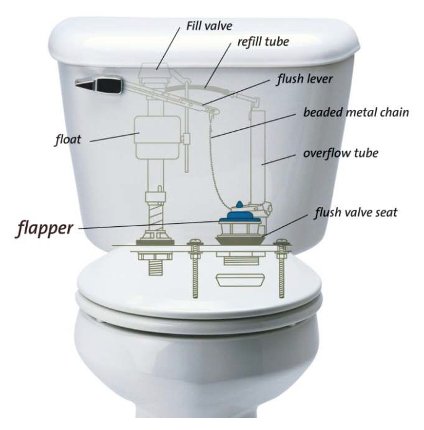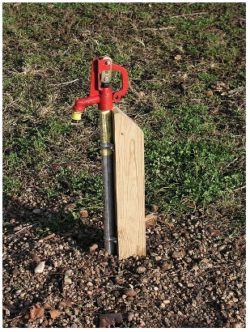So You Suspect You Have a Water Leak?
The best way to monitoring for a potential water leak is by utilizing our online monitoring tool called EyeOnWater. Registration is easy and once logged in, you will be able to see your water usage down to an hourly basis!
Your physical water meter will also show you if you have a leak. One of the 4 rotating screens on your water meter’s display screen is a flow meter. It reads down to 1/100 of a gal per minute. If you’re not using water (or do not have a leak) the flow meter will read zero.

1. The most common source of a water leak is a running toilet.
This occurs when the toilet tank flapper does not properly seat, allowing water from the tank to leak into the bowl. This simple issue can add up to large and unexpected water bills. An easy way of diagnosing this issue is to put food coloring into the tank and see if the color leaks into the bowl.
To resolve a leaky flapper issue first try cleaning the flapper and the lip on the tank drain. If the flapper is warn it can easily and inexpensively be replaced.

2. The second most common source of a water leak is from frost proof yard hydrants.
These devices have a finite life expectancy, and often fail at their underground connection to the water service. Often these leaks starts slow and increases over time. These leaks most often do not reach the surface and can often fool you when investigating.
3. The next place to investigate when searching for a leak is at the water shut-off valve that enters into your house.
Building codes have required a water service shut-off for decades, but older homes may not have one. Your shut-off valve should be located very close to where the water enters your home. Start by looking near your water heater, then check for an in-ground vault along your building’s foundation. You should also check your crawlspace.
By shutting off this valve and checking the water meter again, you can determine if a water leak is most likely associated with your in-ground service line upstream – or if it is downstream of the shut -off valve, likely in or under you house.
The two initial places to investigate an in-ground service line leak are at the connection between the water meter and the service line; and where the service line enters the building through the foundation. Investigate these areas for unusual wet spots. (Don’t forget that whenever you are digging on your property, and especially when you are doing digging around utilities be sure to call 811 to request utility locates!).
If you are planning on uncovering your service line at the water meter, Eastsound Water would encourage you to contact us for a consultation first. We will be happy to discuss the appropriate safeguards to avoid making the situation worse, or risk contaminating your water supply.
Eastsound Water also encourages members to document what they find while investigating their water leak. Pictures of your leak and of your repair are important. Eastsound Water has a Catastrophic Leak Policy that can provide some relief to members who experience high water bills due to leaks. However, this relief is contingent on being able to document an appropriate repair that significantly reduces the chance of a reoccurring problem. Read more about our Catastrophic Leak Policy here.